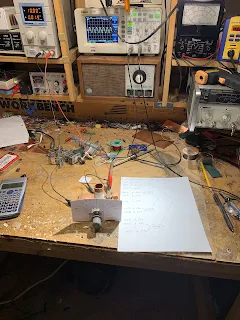Click on the image for a better view
The 15-10 Rig has been performing very well, pulling in a lot of DX contacts on both bands. But there is one thing that has bothered me: The way the transceiver tunes. It can be a bit difficult getting an SSB station tuned in properly. At first I thought this was caused by a lack of lubrication on the variable cap that I've been using (out of an old QF-1), but it turned out that this was not the cause. The problem is something that Pete Juliano has lamented several times: LC style analog VFOs have a tendency to have the frequencies "bunched up" at one end of the tuning range. In other words, the tuning range is far from linear. I was having trouble tuning stations on on the portion of the band where the frequencies were bunched up. I did some quick measurement and found that on this side of the capacitor's tuning range, one turn of the dial would move the frequency about 100 kHz -- that is far too much. On the other end of the capacitor moved only 22 kHz with one turn of the dial (as I recall this is close to the recommended 20 kHz per dial rotation). Clearly I had a lot of the dreaded bunching up. This was what was making tuning difficult.
I had built a pretty standard Colpitts FET VFO. I had a 6.6uH coil, and a 9-135 pF variable cap in series with a 68 pF fixed cap. I was pleased that the VFO worked, and I put it in the circuit. Only later did the bunching up shortcomings become apparent.
I decided to build another VFO, this time paying attention to DIAL SCALE LINEARITY.
I turned to the excellent Bandspread Calculator on Bob Weaver's Electronic Bunker web site: http://electronbunker.ca/eb/BandspreadCalc.html
I plugged in the frequency range that I needed and the values for my variable capacitor. I calculated Cs which was the combined capacitance of the feedback and coupling capacitors. Finally, I had to make a decision about the nature of my variable cap: was it a Midline-Center Cap or was it a Straightline Capacitance cap. I consulted with Bob and he suggested that it might be somewhere between the two. I got out some graph paper and measured it -- it looks to me like a Straight Line Capacitance cap, with the capacitance varying linearly with changes in in the rotation of the shaft.






Just a note that the MVAM109 discrete varactor diode is apparently still sold by W8DIZ at kitsandparts.com, so I enjoy using one of these in a VFO along with 50K and 1K pots in series for coarse and fine adjustment, with a frequency counter measuring down to 10 Hz.
ReplyDeleteGreat. I made a similar bfo for bitx3b 3c which was varactor controlled and used the ik3oil FLL
ReplyDeleteSorry for the typo it for vfo
ReplyDelete